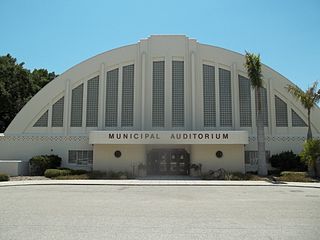
The Sarasota Municipal Auditorium, listed in the National Register as Municipal Auditorium-Recreation Club, is a historic multi-purpose facility built in 1938. It is located at 801 Tamiami Trail North and owned/operated by the municipal government of Sarasota, Florida. The auditorium has 10,000 square feet (930 m2) of exhibit space on its main floor and also contains an Art Deco style stage measuring 1,500 square feet (140 m2).

Walker Memorial Hall is a historic community meeting hall on Highland Road in Bridgton, Maine. Built in 1892 to a design by Frederick A. Tompson, it is a well-preserved local example of eclectic Queen Anne architecture, and continues to be a significant community meeting center, hosting social events and meetings of local organizations. It was listed on the National Register of Historic Places in 1983.

The George Kent Performance Hall is a historic building in Westerly, Rhode Island.

The Camp Sherman Community Hall is the center of social activity in the community of Camp Sherman in central Oregon. The hall hosts a variety of public and private events throughout the year. The building is owned and operated by the Camp Sherman Community Association. Because of its unique rustic architecture and importance to the history of the Camp Sherman area the hall is listed on the National Register of Historic Places.

Old Brick Church, once known as First Presbyterian or North Presbyterian, is a church in Iowa City, Iowa. One of the few surviving pre-Civil War structures in Iowa City, Old Brick was built in 1856 at the site of an older Presbyterian church that had burned. Its steeple was demolished in an 1877 wind storm, it was rebuilt with a crenellated belfry, giving it a distinctive appearance. Last used as a church in 1970, Old Brick was listed on the National Register of Historic Places in 1973 as North Presbyterian Church. In 1974 the University of Iowa purchased the property and intended to demolish the church to make way for a parking lot, but public protest prevented the demolition. This public protest manifested in the formation of Friends of Old Brick, the organization that purchased the structure in 1977. Old Brick changed ownership again in 1987, when Old Brick Episcopal Lutheran Corporation purchased the building. Old Brick now thrives as a community center, hosting such diverse events as weddings, memorials, religious services, academic lectures, humanitarian fundraisers, and dance lessons. Old Brick also houses several non-profit offices.

The Dayton Memorial Hall is a historic meeting venue on First Street in downtown Dayton, Ohio, United States. Constructed shortly after the turn of the twentieth century, this Beaux-Arts structure is one of many memorial halls statewide from the same time period, and it has been named a historic site.
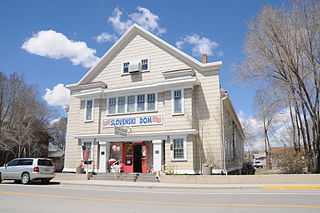
The Slovenski Dom in Rock Springs, Wyoming was built as a community hall for Slovenian fraternal organizations in 1913. The Slovenski Dom, or Slovenian National Home, was one of a number of similar halls built in places with large ethnic Slovenian populations. The organizing charter stipulated that the hall be known as the "Slovenski Dom", its name in Slovenian, rather than by its English translation. It is the only example of its kind in Wyoming and was placed on the National Register of Historic Places in 1997.
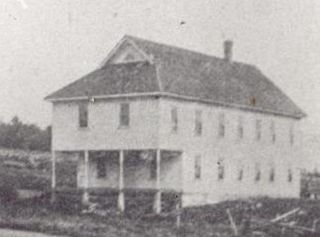
The Oakfield Grange was an historic clubhouse and community meeting space at 89 Ridge Road in Oakfield, Maine. Built in 1906 by the local chapter of the Patrons of Husbandry, the building was for many years the sole social meeting space of any size in the small rural community. It was listed on the National Register of Historic Places in 2006. It has since been demolished.

Comins Hall, also known as the East Eddington Public Hall and the Eddington-Clifton Civic Center, is a historic social and civic meeting hall at 1387 Main Road in Eddington, Maine. Built in 1879, it has since then served as the town's only major social and civic meeting space, hosting town meetings, dances, dinners, Grange meetings, and traveling performers. It was listed on the National Register of Historic Places in 2004.
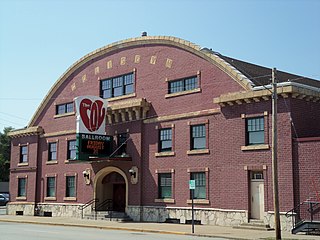
The Col Ballroom is a historic building located in the West End of Davenport, Iowa, United States. It was listed on the National Register of Historic Places and on the Davenport Register of Historic Properties as the Saengerfest Halle.

The Carson Valley Improvement Club Hall is a historic building located at 1606 Esmeralda Avenue in Minden, Nevada. The building was constructed in 1912 as a meeting hall for the Carson Valley Improvement Club. The two-story building features a variety of brickwork patterns but has an otherwise plain design. The Carson Valley Improvement Club used the building to host both community social events and town meetings. The building has served as the informal seat of government in Minden since its construction; after the Carson Valley Improvement Club moved out in 1920, the Minden Commercial Club and later the Minden Town Board continued to hold government meetings at the building. Though Minden is unincorporated, the groups meeting in this building have acted as local liaisons to Douglas County's government and have helped manage local government services. In addition, the building has continued to house a variety of social events, including concerts, movies, religious services, and basketball games.

The Kensington Town House is the town hall of Kensington, New Hampshire. Located at 95 Amesbury Road, the single-story wood frame building was erected in 1846, and has been its only purpose-built municipal hall. It is a good local example of civic Greek Revival architecture, and its hall has historically hosted town meetings and social functions. The building was listed on the National Register of Historic Places in 2013.

The Former Greenwood Town Hall is located at 270 Main Street in Locke Mills, the main village of Greenwood, Maine. Completed in 1931, the building has been a center of civic and social activities since, hosting town meetings, elections, school graduations, dances, and private functions. It was replaced as town hall by the present facilities in 1988, and is now maintained by a local non-profit. It was listed on the National Register of Historic Places in 2001.

The Stonington Opera House is a theatrical venue at the corner of Main and School Streets in the center of Stonington, Maine. Built in 1912, it is one of a small number of early 20th-century performance halls constructed in Maine. It is the current home of Opera House Arts (OHA), a non-profit organization dedicated to restoring and preserving the historic building to its original purpose as a central community institution. The building was listed on the National Register of Historic Places in 1991.

Waverly Village Hall is a municipal event hall in Waverly, Minnesota, United States, built by the Works Progress Administration (WPA) from 1939 to 1940. It was listed on the National Register of Historic Places in 2002 for its local significance in the themes of architecture, entertainment/recreation, and government/politics. It was nominated as a representative of the civic facilities made possible with New Deal federal assistance, as well as for its Moderne architecture and role as a community event space.

The Allentown Union Hall is a historic meeting hall located 2 miles (3.2 km) east of Illinois Route 121 in Allentown, Illinois. The building was built in 1892 to host community events in Allentown, a small rural settlement. Like many small communities nationwide at the turn of the century, the citizens of Allentown wished to expand their educational and cultural horizons; since rough dirt roads made travel outside the community difficult, the community used the hall to host its own cultural events. The Allentown Helping Hand Circle, the community organization that raised the money for the building, hosted many of the hall's early events, which included community dinners and talent shows. The hall also hosted shows put on both by actors and musicians from Allentown and the surrounding area and by traveling acts who stopped in the community. As the only large public building in the area, the town hall also served as a polling place, a clubhouse for women's clubs and fraternal organizations, a church for the community's religious groups, and an auditorium for the local school.

The Enfield Town Meetinghouse is a historic Greek Revival style meeting house located on Enfield Street at South Road in Enfield, Connecticut. Completed in 1775 and moved and restyled in 1848, it hosted the municipal government until the 1920s. Now managed by the local historical society as a museum, it was listed on the National Register of Historic Places in 1974.

The Ripton Community House, formerly the Ripton Congregational Church, is a historic former church and present community hall on Vermont Route 125 in the village of Ripton, Vermont. Built in 1864 for a Congregationalist church, it has since served as a community clubhouse and town-owned meeting hall, and is a fine local example of vernacular Greek Revival architecture. It was listed on the National Register of Historic Places in 1973.

The Mason City YMCA is a historic building located in Mason City, Iowa, United States. The local YMCA was organized in 1892 and it was housed in a variety of places in the city. Various attempts were made to build their own building and properties were acquired and traded before this location was acquired from St. John's Episcopal Church. Charles McNider, a local community leader, led the campaign to build this structure. The Minneapolis architectural firm of Tyrie and Chapman designed the Colonial Revival style building that was built by Madsen Construction Company, also of Minneapolis. Many of the materials used in its construction were produced locally. Even though it was completed late in 1926 it sat empty until all the pledges to complete its construction were fulfilled. The building contained room for athletic facilities, a restaurant, offices, and dormitory rooms on the upper floors.
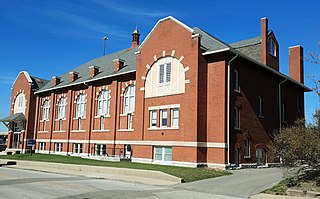
South Side Turnverein Hall is a historic social club and gymnasium in the Bates-Hendricks neighborhood of Indianapolis, Indiana affiliated with the city's German-American community. It was built in 1900 by prominent architects Vonnegut & Bohn, whose managing partners Bernard Vonnegut, Sr. and Arthur Bohn were members of the burgeoning German-American community in Indianapolis. The architects were also known for designing the Athenæum, another German-American social club in the city. The South Side Turnverein was an important gathering place for Indianapolis' south side German community until its decline in the 1940s. It was sold to investors in 1978 to be used as an athletic club.






















